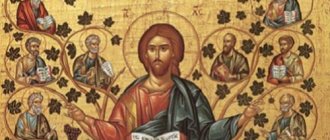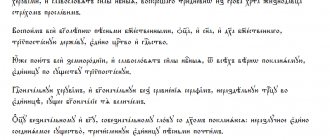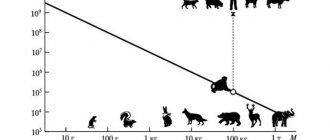«GRAPE
- This is one of the main symbols of the Christian religion. It is therefore not surprising that the vine and grapes are mentioned repeatedly in the Bible.
The Old Testament describes such a bunch of grapes, which the Israelites cut in the land of Canaan, then the quote “... a single bunch of grapes... was held on a pole.” ...they rose and explored the ground...they made a pole out of a branch and carried one bunch of grapes. Two of them carried it on a pole between them, along with pomegranates and figs. This place was called the Valley of Eshkol because of the bunch of grapes that the Israelites cut there. At the end of forty days they returned after exploring the land.
Grapes and wheat are considered the oldest among cultivated plants cultivated by people. The vine was the first plant that Noah planted when he came out of the ark after the flood. In the Old Testament tradition, the vine represented the Jews as God's chosen people.
And what’s interesting is that Grapes in the Bible are mentioned positively only and precisely alive - like a grapevine or fresh grapes. Dried grapes - raisins - are a symbol of death, just like living grapes themselves in the Bible are a symbol of life. The symbolism of raisins as dried grape berries was certainly used in ancient times during funeral rites.
The Cross and Tree of Life are often depicted as vines, and the harvest of grapes as a symbol of the Last Judgment at the end of time.
The symbolism is interpreted by the words of Christ from the Gospel of John: “ I am the vine.”
Also several iconographic compositions associated with this naming. In one of them, Christ in the image of Pantocrator is surrounded by a vine, in the branches of which the apostles and sometimes the Virgin Mary and John the Baptist are depicted. The image of a vine and its branches points to Christ and His Church. The disciple-apostles were interpreted as escapees. The vine and grape bunches also symbolize the components of Communion - bread and wine, the Body and Blood of Christ. The Church.
Most often there is an image of a vine with bunches of grapes: this is either a grape harvest, or birds pecking at the bunches. Such images are intended to point Christians to the central Sacrament of the Church - the Eucharist. “The grapes give wine, just as the Word gave His blood.”
, writes Clement of Alexandria. People or birds pecking at the grapes represent Christians feeding on the Body and Blood of Christ, members
In another version, a vine grows from the Holy Sepulcher, or the pierced rib of Christ, the cluster of which falls into His hands. Christ squeezes wine out of it into a chalice, and it is written: “Drink of it, all of you...”
.
This figurative form corresponds to the Gospel words of the Savior: “For just as the rod cannot produce fruit for itself unless it is on the vine, so also are you unless you abide in Me.
“I am the vine, you are the offspring, and those who are in Me, and I in him,
will produce much fruit; for without Me you can do nothing”
(John 15:4-5). Both these words and the corresponding image have a double meaning, ecclesiological and sacramental.
Grapes in the Bible are also a symbol of the exaltation of a Christian. After all, among Christians there are those who are Christians only in name, but inwardly are far from Christ. God cuts such people off from fellowship with Christ. This cutting off occurs at first invisibly, and then it will take place at the Last Judgment. On the contrary, God cleanses the good branches, removing from them everything that spoils the purity and taste of the wine produced from the vines: these are the so-called watery branches. In relation to true Christians, who should bear only the fruits of virtue, God acts in the same way.
The image of a vine was often used as a decorative motif in early Christian paintings. It is found on the frescoes of Roman catacombs, on Christian sarcophagi, Byzantine mosaics, medieval stained glass windows and stone sculptures. The vine, as a decorative subject for the decoration of temples, continues to exist in the Church to this day with the same symbolic meaning. » __________________________________________________________
THE VINE IS TRUE.
“And I am the true vine, and My Father is the vinedresser. Every branch in me that does not bear fruit He cuts off, and every branch that bears fruit He purges, so that it may bear more fruit.”
(John 15, 1-2). This is how the words of the Lord are quoted and grapes are mentioned in the Bible.
Our Lord and God Jesus Christ calls Himself the Vine, and calls us all branches of this vine. Listen further to what He says: “You have already been cleansed through the word that I preached to you. Abide in Me, and I in you. Just as a branch cannot bear fruit by itself unless it is in the vine, so neither can you unless you are in Me.”
It is quite clear to you that a branch that has not retained the connection with its vine, of course, cannot bear fruit.
She lives and brings forth beautiful bunches of grapes by the power of the juices coming from the root of the vine.
And so the Lord Jesus Christ says that we too must be in the same close, inextricable connection with Him, like the branches with the root of a vine.
“Abide in Me, and I in you.” Only under this condition, if we abide in Him, and He in us, will we bear beautiful fruits pleasing to God.
How can we understand these amazing words of the Lord Jesus Christ: why does He call Himself the Vine, the true Vine? Why does He say that if we do not feed on the juices of this vine, we will become dry branches that bear no fruit? Why are grapes mentioned so reverently in the Bible?
To answer this question, we need to think about the meaning of the incarnation of the Lord Jesus Christ and His death on the cross.
Why was it necessary for God Himself, the Second Person of the Holy Trinity, to become a true Man?
Why was it necessary for this true God and together true Man to give His Divine blood for the salvation of the world - why was this necessary?
This was necessary so that we could become partakers of the nature of God. You see what a terrible, what a great goal: to become partakers of the nature of God.
Grapes in the Bible and Orthodoxy are meaningful and figurative. You hear at every liturgy: “Take, eat: this is My Body, which was broken for you for the remission of sins. Drink from it all; This is My Blood of the New Testament, which is shed for you and for many for the remission of sins.”
What do we read in Holy Scripture about blood? We read very scary and important words, for it is written: “The soul is in the blood of the body.”
. The soul is in the blood, in the blood of the body. His Divine soul dwelt in the Blood of the God-Man. And He gave this Blood together with the Flesh to us for food and drink.
He said: “ He who eats My Flesh and drinks My Blood has eternal life.”
(John 6:54).
“I am the living bread that came down from heaven: whoever eats this bread will live forever; And the bread that I will give is my flesh, which I will give for the life of the world.”
(John 6:51).
“Except you eat the flesh of the Son of Man and drink His blood, you have no life in you.”
(John 6:53).
True life is impossible without the assimilation of the Blood of Christ and His Flesh. They can be compared to the juices of a vine. The Lord feeds us all with these juices.
When we partake of the Body and Blood of Christ, something greatest happens to us, something truly terrible - we truly become partakers of His Body and Blood. And the Soul of Christ, which is in His Blood, is perceived by us with His Blood.
We thus become partakers of the soul of Christ.
Do you understand how big and scary this is?! Together with the Blood of Christ, which we partake of in the great sacrament of the Eucharist, we perceive molecules, particles of His Body.
These particles of the Divine Body, the Divine Blood become particles of our own body, we become partakers of both the Body of Christ and His Blood, we become partakers of the Soul of Christ.
Therefore, this is precisely why the Lord Jesus Christ said that if we are not branches of the Vine, if we do not feed on the juices of the Vine - the true Blood of Christ - we cannot do anything good, for He further said: “Without Me you cannot do anything.”
Only with Him, with His grace, having become partakers of the Blood and Body of Christ, can we do good. Without this we cannot do anything good.
Everything else done without Christ is worthless, all of it is worthless and despicable in the eyes of God.
We create truth and goodness only by His grace; only those fruits that we grow by feeding on the juices of the Vine are true and good.
“Abide in Me and I in you. Just as a branch cannot bear fruit by itself unless it is in the vine, so neither can you unless you are in Me.”
And if you remain, if you always maintain a living connection with the True Vine, then what Christ says will happen: “Every branch (of Me) that does not bear fruit He cuts off, and every branch that bears fruit He cleanses, so that it may bear more fruit.” .
“I am the Vine, and you are the branches. Whoever does not abide in me will be cast out like a branch and wither, but such branches are gathered and thrown into the fire and burn.”
These are terrible words: it is terrible that even the branches of the Vine, that is, us Christians, are cut off by God if we do not maintain a true connection with the roots of the Vine. And if we bear fruit, He purifies each fruit-bearing branch, making it capable of bearing more and more fruit.
“If you abide in Me, and My words abide in you, ask whatever you wish, and it will be done for you.”
In order to have everything that we ask in prayer, it is necessary to be fruit-bearing branches of the True Vine, it is necessary to always feed on the juices of this Vine.
“By this my Father will be glorified, that you bear much fruit, and that you become my disciples.”
You see, we can even glorify God if we become fruitful branches of the True Vine, which is our Lord and God Jesus Christ. For us to glorify God, it is only necessary that we be living branches doing good, doing the will of Christ, the will of the True Vine.
Remember that by partaking of the Blood and Body of Christ, you become partakers of His soul, drinking the life-giving juices of the True Grape Vine. Amen." Archbishop Luke (Voino-Yasenetsky).
I know two icons of the Mother of God with the image of grapes (maybe there are more) The first You are the Vine,
This icon was based on a fresco in the temple in Capodocia; an image of a bunch of grapes and a blessing gesture with the left hand were added to its iconography. The icon is recognized by the Georgian Church, has a troparion and akathist, the day of remembrance is January 1 (Old Art.) / January 14 (New Art.). This icon has already become famous as a miraculous one.
Akathist...You
—
A
vine ,
newly blossoming A tender branch, planted in Eden and by Yourself You are the Shining Sun... listen to the choir of the Temple of St. Panteleimon...
The second is the Most Holy Theotokos Covering. Origin: From the Seraphim-Znamensky monastery on the southern outskirts of Moscow (the village of Bityagovo, Domodedovo district). Location: Novospassky Monastery in Moscow. Material: Wood. The Icon of the Most Holy Theotokos “Covering” (Domodedovo) was a cell image of the Georgian letter to Schema Abbess Tamar (Marjanishvili, 1868–1936) - the founder of the Seraphim-Znamensky monastery on the southern outskirts of Moscow (village Bityagovo, Domodedovo district). The Venerable Martyr Elisaveta Feodorovna (Romanova) took an active part in the creation of the monastery. In the icon, according to the description of the confessor of the monastery, Hieromartyr Bishop Arseny (Zhadanovsky), “The Mother of God covers with a headscarf and, as if from someone, protects the Infant of God, and He holds in his hand a bunch of grapes - the emblem of Holy Communion, during which no adversity is scary...”
On August 15, the celebration of “Our Lady of the Vine and Grapes”, connected with the Assumption, is celebrated, where the Mother of God is identified with “the beautiful vine that gave the world a divine bunch, from Her the wine will water the universe.” Source.
_________________________________________________
An interesting parallel can be drawn when considering the topic of Grapes in the Bible.
During the Bishop’s service, before the singing of “Holy God” by the performers, the Bishop goes out onto the solea with a cross and trikiri and, contemplating the praying people who believe in the Lord - the “spiritual wind city” (garden of God), turns to the Heavenly Wind City with the words: “Look from heaven, O God, see and visit these vines, and establish them, and Thy right hand plant them.”
The grapes refer to the Christians present. But there are different varieties of grapes. Therefore, black, red and white. Natural associations arise: black grapes represent monastics, and red and white grapes represent lay people. INTERESTING . Dark varieties are recognized as the healthiest grape varieties. The berries are dark in color due to the substances they contain. Moreover, the richer the color, the healthier the grapes.
As is known from the canons of the Holy Orthodox Church, deep red color symbolizes the Blood of Christ, therefore only red wine obtained from black grape varieties is used during worship.






